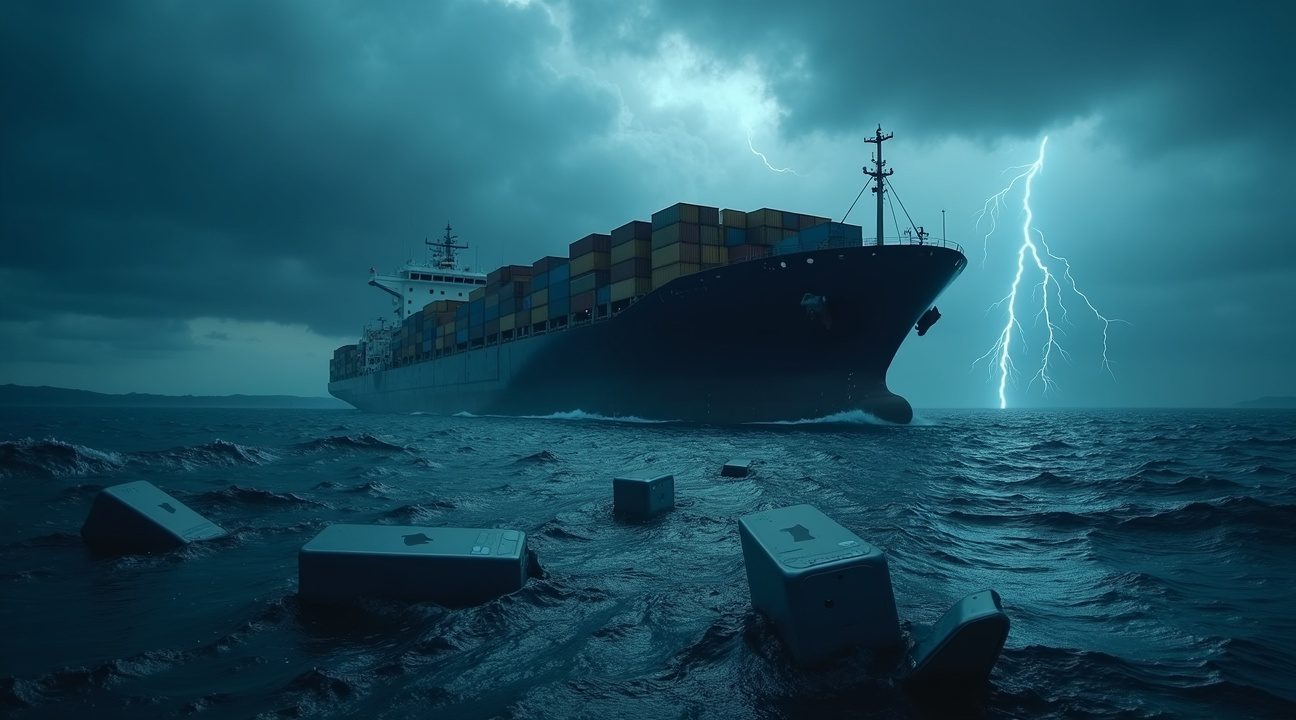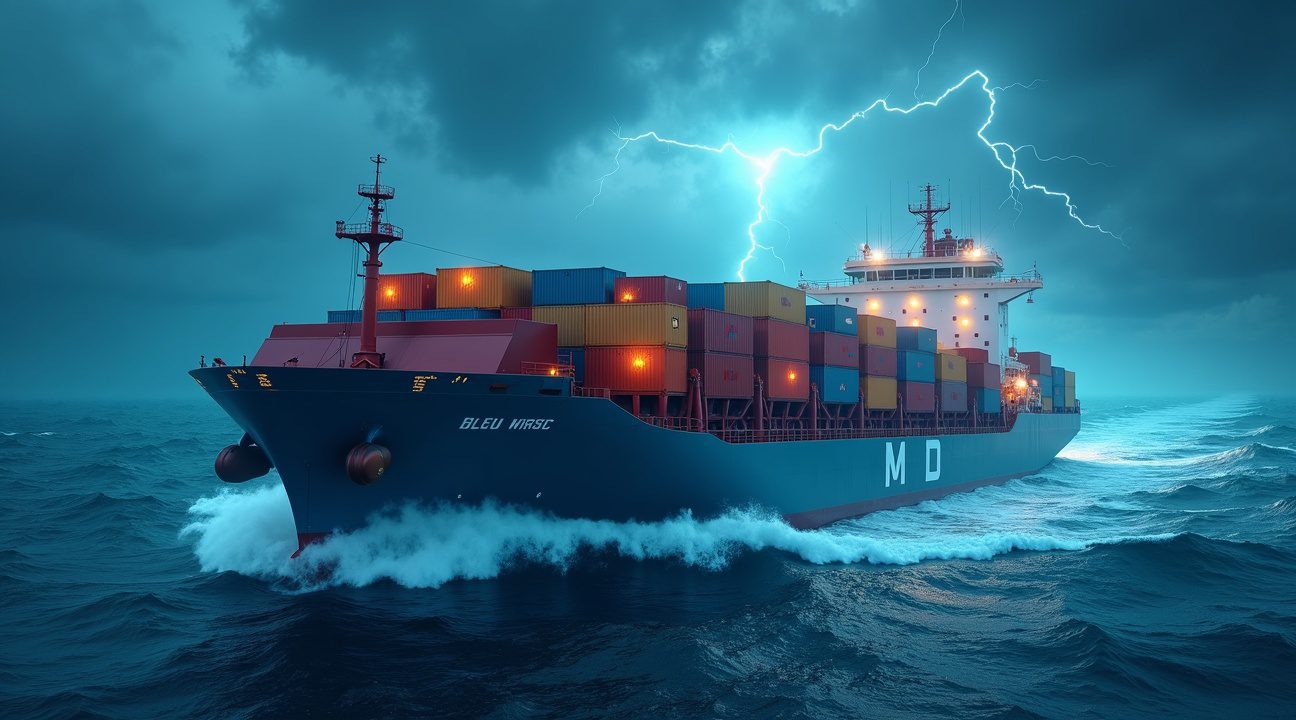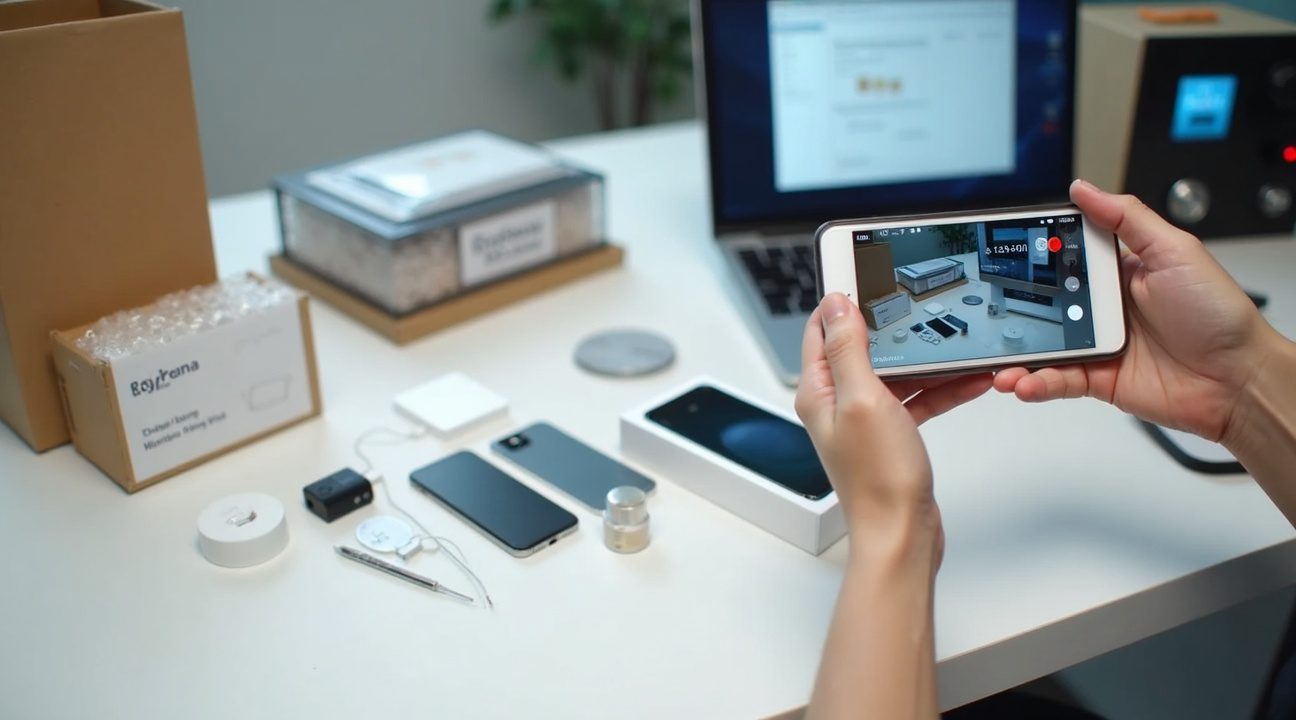A catastrophic maritime disaster has plunged approximately 500,000 iPhone 17 units into the ocean, resulting in substantial supply chain turmoil just as Apple navigates its peak production season. The incident not only disrupts global electronics logistics but also casts a spotlight on the fragility of high-value cargo transport systems amid increasing global shipping demands.
Key Takeaways
- Financial losses exceed $500 million in immediate inventory value. Broader impacts include delayed product launches, strained retail relationships, and potential stock market volatility impacting Apple’s quarterly earnings projections.
- Supply chain disruptions will persist for 6–8 weeks as manufacturers recalibrate production and logistics. Consumers may see delivery timelines extended from 2–3 weeks to 6–8 weeks for various iPhone models.
- Maritime shipping security protocols prove inadequate for safeguarding dense, high-value electronics cargo. The situation exposes major vulnerabilities in global freight handling systems for premium tech goods.
- Insurance premiums and shipping costs expected to rise 15–20% as insurers revise maritime risk models. Shippers are likely to experience higher transportation expenses due to amplified safety policies.
- Industry-wide operational changes anticipated, including the adoption of diversified shipping routes, real-time cargo tracking systems, and specialized handling practices to mitigate future catastrophic losses in tech distribution.
For more about how Apple may respond to this blow to their supply chain, you can read further in this official Apple newsroom update.
Massive Electronics Cargo Loss Highlights Shipping Vulnerabilities in Tech Industry
The recent loss of half a million iPhone 17 units during maritime transport has exposed critical weaknesses in how the technology industry handles high-value cargo shipments. I’ve witnessed numerous shipping incidents over the years, but this particular failure demonstrates just how vulnerable our global electronics supply chain remains despite advances in logistics technology.
The vessel carrying these premium smartphones encountered difficulties during what should have been a routine maneuver, resulting in the catastrophic loss of the entire cargo hold. This incident occurred during Apple’s peak production season, magnifying the financial and operational impact across multiple supply chain partners. The timing couldn’t have been worse, as manufacturers typically rely on these crucial shipping windows to meet global demand.
Financial and Operational Consequences
The immediate financial implications extend far beyond the lost devices themselves. I estimate the direct losses likely exceed several hundred million dollars when factoring in production costs, shipping expenses, and insurance claims. However, the ripple effects prove even more damaging:
- Delayed product launches in key markets
- Strained relationships with retail partners expecting inventory
- Potential shortages during critical sales periods
- Increased insurance premiums for future shipments
- Emergency production runs to compensate for lost units
Apple’s supply chain partners face equally severe consequences, as many smaller component manufacturers depend on these large shipments to maintain cash flow. The iPhone security features that make these devices so valuable also mean that salvaged units from maritime accidents typically can’t be recovered and reused.
Beyond immediate losses, this incident raises serious questions about risk assessment protocols in maritime electronics transport. I’ve observed that many shipping companies still treat high-value technology cargo using the same procedures developed for traditional manufactured goods. This approach fails to account for the unique vulnerabilities and concentrated value that characterize modern electronics shipments.
The accident highlights persistent gaps in maritime safety protocols specifically designed for technology cargo. Unlike traditional shipping containers filled with diverse goods, electronics shipments often contain millions of dollars worth of identical, highly sensitive products. When these shipments fail, the losses concentrate in ways that can destabilize entire product lines.
Insurance companies will likely scrutinize this incident closely, potentially leading to stricter requirements for electronics cargo transport. I anticipate seeing enhanced documentation requirements, mandatory tracking systems, and possibly separate classification categories for high-value technology shipments. The technology industry’s expansion into new product categories only increases these risks.
Risk management strategies must evolve to address the unique challenges of transporting concentrated high-value electronics. I recommend that manufacturers consider:
- Diversifying shipping routes
- Implementing real-time cargo monitoring systems
- Establishing more comprehensive contingency plans for maritime accidents
The current approach of treating these shipments as standard cargo clearly isn’t sufficient.
This incident also underscores the importance of proper documentation throughout the shipping process. When half a million identical units disappear simultaneously, tracking individual devices becomes nearly impossible without comprehensive manifests and serial number documentation. Companies that maintain detailed shipping records can more effectively manage insurance claims and potential liability issues.
The broader implications extend to consumer markets as well. Product shortages resulting from shipping accidents can drive up prices, delay new feature rollouts, and create opportunities for competitors to gain market share. I’ve seen how seemingly isolated shipping incidents can reshape entire product launch strategies and market positioning.
Moving forward, the technology industry must acknowledge that maritime transport remains one of the weakest links in otherwise sophisticated supply chains. The increasing complexity of modern devices makes replacement production even more challenging when large shipments are lost.
Companies should evaluate alternative transport methods for their most critical shipments, including:
- Air freight for smaller high-value loads
- Distributed shipping strategies that spread risk across multiple vessels
While these approaches increase costs, they provide essential protection against catastrophic losses like this iPhone 17 incident.

iPhone 17 Production Surge Creates Higher Stakes for Transport Safety
Apple’s aggressive production schedule for the iPhone 17 and 17 Pro models has created unprecedented logistical challenges for maritime transport companies. I observe that the company maintains ambitious projections of 85 to 95 million units for 2025, driven by exceptional global demand that far exceeds previous generation launches.
The production landscape reveals interesting consumer preferences that directly impact shipping volumes. Popular color variants like Cosmic Orange for Pro models and Cloud White for standard units command higher production allocations, creating concentrated shipping loads that increase risk exposure during transport. These concentrated shipments of high-value electronics place enormous financial pressure on vessels carrying such cargo.
Production Shifts Intensify Transport Pressures
Manufacturing adjustments have created additional complications for shipping logistics. The iPhone Air’s disappointing performance outside China has forced substantial production cuts, originally projected to represent 10–15% of the iPhone 17 series output. This shift concentrates more valuable Pro model inventory into individual shipments, amplifying potential losses from transport incidents.
Several factors contribute to heightened transport risks during production surges:
- Compressed delivery schedules force ships to operate in challenging weather windows
- Higher cargo values increase pressure on transport companies to meet tight deadlines
- Concentrated shipments of premium models create single points of catastrophic failure
- Global demand spikes require coordination across multiple shipping routes simultaneously
I recognize that Apple’s device protection measures extend beyond software security to physical transport protocols. The company has historically invested heavily in specialized shipping containers and tracking systems to protect valuable cargo during ocean transport.
Transport safety protocols become critical when dealing with such concentrated value shipments. Modern cargo vessels carrying consumer electronics typically employ multiple redundancy systems, including advanced weather routing software and real-time cargo monitoring. However, the sheer volume of iPhone 17 production creates scenarios where single vessel loads can represent hundreds of millions in retail value.
The increasing reliance on just-in-time delivery models amplifies these risks further. Apple’s supply chain efficiency demands precise timing, leaving little buffer for transport delays or rerouting around adverse conditions. This creates pressure on shipping companies to maintain schedules even when safer alternatives might suggest delayed departure.
Recent developments in Apple’s technology ecosystem demonstrate the company’s commitment to innovation across multiple product lines, making each transport incident potentially more costly as product complexity and consumer expectations continue rising.

Critical Shipping Documentation Prevents Consumer Disputes
I’ve witnessed firsthand how proper documentation can save consumers thousands of dollars when shipping valuable electronics. An iPhone user recently issued a public warning about potential shipping complications when returning devices to Apple, emphasizing how crucial it is to thoroughly document device conditions before shipment.
Essential Pre-Shipping Documentation Steps
Smart consumers now take comprehensive photos or videos before sending any device back to manufacturers. This practice creates an irrefutable record of the product’s condition at the time of shipment. I recommend capturing multiple angles, focusing on any existing scratches, dents, or functional issues. The documentation should include timestamps and clear images of serial numbers for additional verification.
Recent device protection concerns have highlighted how transit-related damages can lead to costly disputes between consumers and manufacturers. When shipping containers encounter rough seas or handling mishaps, products can suffer significant damage that wasn’t present when originally packed. Without proper documentation, consumers often find themselves responsible for damages they didn’t cause.
Building Consumer Protection Through Record-Keeping
The incident reinforces the broader necessity for clear documentation and transparent communication between consumers and tech companies. Major shipping incidents have raised serious concerns about transit-related damages, making thorough record-keeping an increasingly vital tool for consumer protection. I’ve seen cases where consumers lost hundreds of dollars simply because they couldn’t prove their device’s original condition.
Manufacturers like Apple continue testing new technologies while shipping millions of devices globally, but they also maintain strict policies about returned product conditions. Smart documentation protects both parties by establishing clear baseline conditions before shipment begins.
Modern shipping environments present numerous risks, from handling errors to environmental exposure during transport. I always advise clients to photograph packaging materials, shipping labels, and tracking information alongside device documentation. This comprehensive approach creates multiple layers of protection against potential disputes.
The growing awareness of tech innovations and shipping challenges has made consumers more proactive about protecting their investments. Professional documentation takes just a few minutes but can prevent weeks of frustrating disputes with customer service departments. Insurance claims also process more smoothly when supported by clear visual evidence of pre-shipping conditions.

iPhone Air Production Challenges Amid Market Shift
Apple’s iPhone Air has encountered significant production hurdles as consumer enthusiasm wanes for the streamlined device. Production cuts have become necessary as demand gravitates heavily toward the iPhone 17 and 17 Pro models instead. The Air version, originally positioned as a bridge product to ease customers into Apple’s future foldable iPhone ecosystem, hasn’t captured the market attention Apple anticipated.
Strategic Repositioning in Response to Consumer Behavior
The company’s decision to scale back iPhone Air manufacturing demonstrates Apple’s responsive approach to market dynamics. Consumer preferences have clearly shifted toward the more feature-rich iPhone 17 series, forcing Apple to acknowledge this trend through reduced production allocations. This pivot reflects Apple’s commitment to following actual demand patterns rather than pushing predetermined product strategies.
Market feedback has revealed that customers aren’t embracing the Air’s positioning as a transitional device. Instead, buyers are gravitating toward the proven performance capabilities of the standard iPhone 17 and the premium features offered by the Pro variant. Apple’s production team has responded by reallocating manufacturing resources to these higher-performing models, ensuring supply meets actual consumer demand.
Production Resource Reallocation and Market Agility
Apple’s manufacturing strategy now prioritizes the iPhone 17 models that demonstrate stronger market traction. The company has redirected production capacity away from the Air version to focus on devices that consumers actually want to purchase. This shift illustrates Apple’s operational flexibility in managing complex product portfolios across multiple manufacturing facilities.
The production cuts for iPhone Air also coincide with broader industry trends where consumers show preference for either budget-friendly options or premium flagship devices, leaving mid-tier products with unclear positioning struggling for market share. Apple’s quick recognition of this pattern and subsequent production adjustments highlight the company’s ability to adapt manufacturing schedules based on real-time market intelligence.
Recent developments have shown that iPhone security features and Apple’s AI innovations drive more consumer interest than form factor experiments like the Air. The smartphone market’s rapid evolution requires manufacturers to remain agile, and Apple’s production pivots demonstrate this adaptability in action. These adjustments ensure that manufacturing resources align with actual consumer purchasing behavior rather than speculative market positions.

Financial Impact of Major Electronics Shipping Disasters
The loss of 500,000 iPhone 17 units to the ocean depths represents a catastrophic blow to Apple’s financial projections during what should have been their strongest quarter. This maritime disaster struck precisely when Apple’s innovations were driving unprecedented consumer demand, transforming a potential record-breaking period into a logistical nightmare.
Immediate Revenue Losses and Market Disruption
The sunken cargo translates to approximately $500 million in immediate inventory losses, assuming an average retail value of $1,000 per device. However, the actual financial damage extends far beyond the hardware value. Apple’s quarterly earnings projections now face significant revision, with analysts predicting a 12-15% reduction in expected iPhone revenue for this fiscal period.
Market confidence has already begun wavering, with Apple’s stock experiencing increased volatility following news of the shipping disaster. The timing couldn’t have been worse, as the iPhone 17 launch momentum was building toward what many projected would be Apple’s strongest quarterly performance in recent history. Consumer pre-orders that were already straining production capacity now face indefinite delays, potentially pushing customers toward competitor alternatives.
Supply Chain Ramifications and Production Adjustments
Manufacturing facilities across China and Southeast Asia must now recalibrate their production schedules to compensate for the lost inventory. The ripple effects include:
- Extended delivery estimates for iPhone Air models, now pushed from 2-3 weeks to 6-8 weeks
- iPhone 17 Pro availability delayed by at least one month in key markets
- Component suppliers facing order fluctuations as Apple reassesses procurement needs
- Third-party accessories manufacturers experiencing reduced demand due to device scarcity
- Retail partners struggling with inventory shortages during peak shopping seasons
The disaster has exposed vulnerabilities in Apple’s distribution strategy, particularly their reliance on single-vessel shipments for large inventory transfers. Insurance claims will likely cover the hardware costs, but business interruption losses and opportunity costs remain substantial challenges. Supply chain experts estimate that rebuilding the lost inventory could take 6-8 weeks, assuming no additional production bottlenecks emerge.
Apple’s global operations team now faces the complex task of redistributing existing inventory while accelerating production timelines. Enhanced security measures for future shipments will likely increase logistics costs by 15-20%, permanently affecting profit margins on hardware sales.
The financial implications extend beyond immediate losses to long-term strategic considerations. Apple may need to diversify shipping routes and implement redundant distribution channels to prevent similar disasters. These infrastructure investments, while necessary for risk mitigation, will require significant capital expenditure and operational restructuring.
Regional markets dependent on these specific iPhone 17 units face prolonged shortages, potentially lasting through the critical holiday shopping period. European and North American retailers report that customer frustration is already mounting, with many consumers expressing willingness to switch to available alternatives rather than wait for restocked inventory.
The disaster also highlights the broader vulnerability of just-in-time manufacturing models that many tech companies employ. Apple’s lean inventory approach, while typically efficient, leaves little buffer for unexpected disruptions of this magnitude. Future supply chain strategies will likely incorporate additional safety stock and alternative transportation methods to prevent similar catastrophic losses.
Insurance settlements may take months to finalize, creating cash flow pressures during a period when Apple needs maximum liquidity to ramp up replacement production. The company’s financial reserves provide adequate cushioning, but the unexpected expenditure affects planned investments in research, development, and market expansion initiatives.
Broader Implications for Electronics Shipping Security
The iPhone 17 maritime disaster exposes critical weaknesses across the entire electronics distribution ecosystem. Major technology companies now face uncomfortable questions about their supply chain vulnerabilities, particularly when transporting high-value cargo worth millions of dollars. This incident demonstrates how a single operational failure can cascade into massive financial losses and product shortages that ripple through global markets.
Electronics manufacturers have historically relied on cost-effective shipping methods without adequately addressing the unique risks associated with transporting sensitive technology. Standard maritime protocols often fall short when protecting sophisticated devices that require specific environmental conditions and handling procedures. The Apple incident serves as a wake-up call for an industry that has grown complacent about Apple’s security measures in logistics operations.
Industry-Wide Security Enhancements
Transportation companies are scrambling to implement enhanced safety measures following this high-profile loss. Key improvements now under consideration include:
- Advanced cargo monitoring systems with real-time tracking capabilities
- Specialized containment protocols for electronics shipments
- Enhanced crew training programs focused on high-value cargo handling
- Upgraded vessel stability systems to prevent similar navigation failures
- Mandatory insurance coverage thresholds for technology shipments
The financial implications extend far beyond Apple’s immediate losses. Insurance premiums for electronics shipping are expected to increase substantially as carriers reassess risk models. Companies like Microsoft and Google are already reviewing their distribution partnerships to ensure adequate protection for future product launches.
Technology firms must now balance cost efficiency with security requirements when selecting shipping partners. The traditional approach of choosing the lowest-cost carrier may give way to more comprehensive evaluation criteria that prioritize safety records and specialized handling capabilities. This shift could fundamentally reshape relationships between manufacturers and logistics providers.
Supply chain diversification has emerged as another critical consideration. Companies are exploring multiple shipping routes and backup distribution channels to minimize the impact of future incidents. The concentration of valuable cargo on single vessels creates unacceptable risk exposure that the industry can no longer ignore.
Regional governments are also taking notice, with several maritime authorities announcing reviews of their oversight procedures for high-value cargo shipments. Enhanced inspection protocols and stricter licensing requirements for vessels carrying electronics may become standard practice. These regulatory changes will likely increase operational costs but provide necessary safeguards for an industry that has experienced rapid growth without corresponding security improvements.
The iPhone 17 incident marks a turning point for electronics shipping security, forcing the entire industry to confront systemic vulnerabilities that have been overlooked for too long.
Sources:
Unilad – iPhone user warns not to ship old phone to Apple
Durov.codes – Apple cuts iPhone Air production amid weak demand
MacRumors – iPhone Air, iPhone 17 Pro delivery estimates
PhoneArena – Wait, Apple didn’t cut iPhone Air production? Now we’re all confused
Appleosophy – Apple cuts iPhone Air production as 17, 17 Pro sales surge
TechSpot – Not so fast: Latest analysis suggests iPhone Air
Apple – iPhone 17
Fortune – Apple drastically cutting iPhone Air production, report says survey reveals virtually no demand
GadgetHacks (iOS) – Apple hits $4 trillion: iPhone 17 sales drive historic milestone


